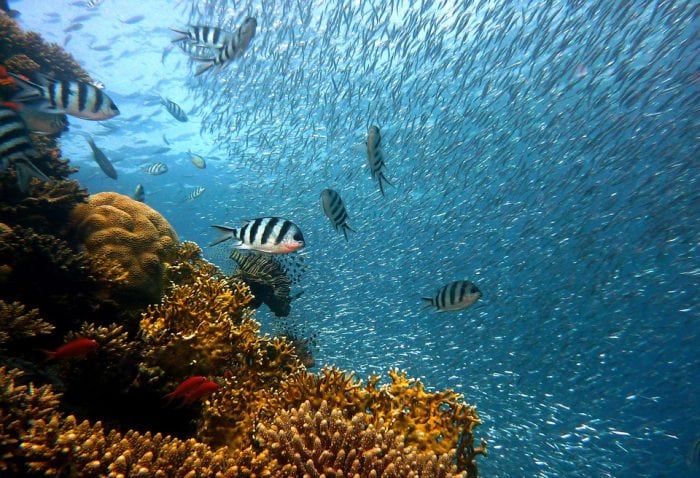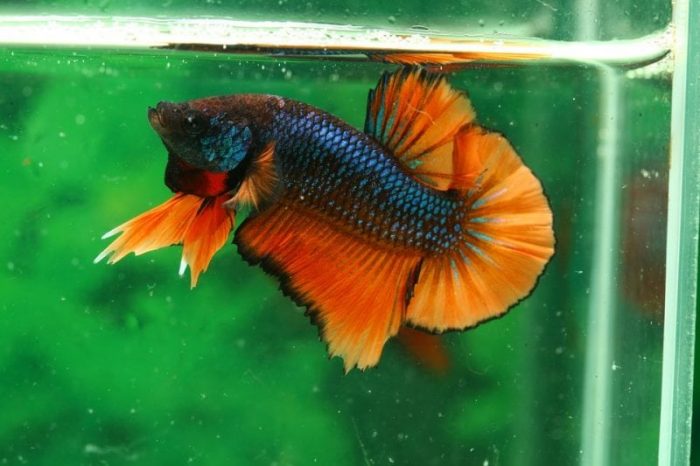
Fish are great pets to have and eat a variety of different things, from flakes and pellets all the way to small shrimp and even veggies.
This food is something that you will be able to purchase at your local pet store where you got your fish, and costs may vary. To get an in-depth detail about what your pet fish eats, check out this guide.
My mother early on taught us to respect all animals, and I mean all animals – not just cats and dogs but rats and snakes and spiders and fish and wildlife, so I really grew up believing they are just like us and just as deserving of consideration. – Joanna Lumley
Obviously, and this should go without saying, there is no one answer to this. I can’t say “all fish eat this food”. Instead, fish eat a specialized diet based on their species and dietary needs. For instance, a Koi fish does not eat the same kind of food that a 25¢ goldfish from Walmart will eat. Because of this, it is very important to research and talk to the people at the pet store about what your pet fish will end up needing.
What Do Different Fish Eat?
Since there are so many different kinds of fish we wanted to give a list of the top 5 best fish for beginners and go over what they eat and the care they will need. The majority of these fish I have personally owned and they are very hardy fish to have. If you are wanting to look for a specific breed’s diet you should Google it specifically. You can look up, for example, “what to feed my goldfish” and you will find a bunch of information on that individual fish’s dietary needs. When getting a fish remember to keep these things in mind:
- Water temperature
- Food and diet
- Choose between gravel and sand
- Choose a good net
- Get water conditioner
We wanted to include a video about setting up your first aquarium. The video is about 10 minutes long but it is extremely helpful and gives great tips for starters.
Top 5 Fish For Beginners And What They Eat
1. Neon Tetra
| Facts | |
| Size | Max 1 1/2 inches |
| Color | Bright, vivid coloring |
| Scientific Name | Paracheirodon innesi |
| Diet | Generic fish flakes, can eat shrimp or bloodworms |
| Lifespan | Max at 8 years |
| Tank size | At least 10-gallon tank needed |
| Water needs | Water pH level of 5.5 |
| Temperature | Between 72 and 78 degrees is best |
| Salinity | Freshwater fish |
| Hostile? | No |
This is one of the more popular beginner fish are neon tetras. These guys are super easy to care for, look great in your tank, and are pretty forgiving when it comes to water conditions (at least in my experience). These guys are originally from Malaysia where they are farm raised, and if you want to make them feel at home you can add rocks and wood to your tank.
Their diet is pretty simple and can eat higher quality fish flakes. They are also omnivores, meaning they can eat both meat and plants, so they can also eat bloodworms and small brine shrimp. This will provide protein for these little guys so they can grow and live longer.
2. Betta

A beautiful betta fish. Image source: Pixabay
| Facts | |
| Size | 2 1/2 inches long |
| Color | Ranges from blue and red to black and white |
| Scientific Name | Betta splendens |
| Diet | Carnivore- Betta flakes and some other meat products |
| Lifespan | Around 3 years |
| Tank size | Minimum tank size 1 gallon |
| Water needs | 7 (neutral) |
| Temperature | 75 to 80 degrees, Bettas thrive in warm environments |
| Salinity | No, freshwater fish |
| Hostile? | Very, cannot be placed in a tank with other fish |
Bettas, or Japanese fighting fish, are extremely popular fish that many people have owned. They are easily recognizable and are great fish to have around. A big thing about bettas is that they need at least a 1-gallon tank, not one of the very small ones you can find at pet stores. They also don’t like water currents since they actually breathe from the surface of the water. They can also be super aggressive so they do need to be kept alone in their tank.
Bettas can eat betta flakes or pellets (often found near where you can choose your betta at the store) and can even eat bloodworms for protein. If you buy them frozen food remember to thaw it before feeding it to them. If your betta is your you will need to crush up the flakes so they don’t choke on it.
3. Cory Catfish
| Facts | |
| Size | Can grow to almost 3 inches long |
| Color | Darker grey to brown coloring |
| Scientific Name | Corydoras |
| Diet | Fish flakes, bottom feeder tablets, and pellets |
| Lifespan | Up to 5 years |
| Tank size | |
| Water needs | pH needs to be around 7.0 to 7.8 |
| Temperature | Needs to be between 72 to 78 degrees |
| Salinity | No, freshwater fish |
| Hostile? | Very peaceful |
These fish are very easy to care for, in part, because they are bottom feeders. That means that they are almost like the vacuum cleaners in your aquarium. These little guys eat the flakes and pellets that sink to the bottom of your tank, but you can also give them bottom feeder food if it isn’t enough for them to survive on. Overall great fish to have and a must have in most aquariums to help clean up.
4. Plecostomus
| Facts | |
| Size | Can be over 12 inches long |
| Color | Dark black to dark brown coloring |
| Scientific Name | Hypostomus plecostomus |
| Diet | Omnivore, and bottom feeder. Will eat food pellets, flakes, and bottom feeder pellets. Can also eat algae and veggies |
| Lifespan | 10 to 15 years |
| Tank size | 20 gallons |
| Water needs | Thrive in water between 7.0 and 8.0 pH |
| Temperature | Between 70 to 80 degrees is best for plecos |
| Salinity | No, freshwater |
| Hostile? | No, very peaceful |
This is another bottom feeding fish and will clean your tank for you, just like the catfish does. One great thing about plecos is that they eat algae that grow on your tank, making it look great. You can also give it cucumbers by securing it in the bottom of the tank. It is important to feed your pleco daily, so make sure you stay on top of it.
5. Guppies
| Facts | |
| Size | 2 inches max |
| Color | Colors range based on specific breeds |
| Scientific Name | Poecilia reticulata |
| Diet | Flakes and dried foods are best |
| Lifespan | 4 years |
| Tank size | 10 gallon at least |
| Water needs | Needs a pH between 7.0 to 8.0 |
| Temperature | 68 to 85 degrees |
| Salinity | No, freshwater fish |
| Hostile? | No, very peaceful |
These fish are pretty forgiving and are great for beginners. They eat fish flakes, pellets, and some freeze dried foods. In my experience, the flakes work very well, but they do require variety in their diet. They do well in groups, so, get a few of them for your tank.









